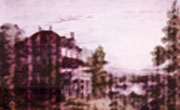
| teaching and creating |  |
|
|
FrankenMOO
Romantic High School Module Inside Gothic Landscapes "I pursued nature to her hiding-places. . . . I collected bones from charnel-houses; and disturbed, with profane fingers, the tremendous secrets of the human frame. In a solitary chamber, or rather cell, at the top of the house, and separated from all the other apartments by a gallery and staircase, I kept my workshop of filthy creation" --Frankenstein Skill Sets: By examining the relationship between character and background in Frankenstein, students learn a fundamental dynamic of literary texts. As students look for spaces that have a similar dynamic and others that contrast with the student's chosen background, they learn how to compare and contrast spaces. Additionally, they learn how to read not only the novel, but other students' projects. Project: As in many gothic novels, space is important in Frankenstein. Characters often find themselves in physical environments that complement their interior emotional states. At other times, characters discover themselves in places that dramatically contrast with how they feel. In both cases, places in the novel help the reader to understand more about the characters. Environments are more than neutral backdrops for characters’ actions; space is the place where characters get defined. In social and natural settings, characters answer for themselves the question the monster continually asks “Who am I? What am I? Why was I made?” Additionally, some characters are not allowed into particular spaces of the novel. Either they do not know about the spaces, they do not like the environments, or they are not allowed in by other characters. Exclusion from a space can tell the reader just as much as inclusion. Finding out why a character does not fit or is not allowed in an environment helps explain the character's identity and dynamics between characters in the novel. Finally, many environments of Frankenstein clash. Domestic space contrasts with natural space, wild nature contrasts with natural serenity, private spaces contrast with public, and legal spaces contrast with illegal spaces. Since space mirrors interior states of the characters, contrasting environments reveal contrasting social and psychological forces in the novel. The following exercise is devised as an interactive comparison and contrast by which students can trace the dynamic exchange between physical spaces and characters' psychological states. Step 1. Choose a
Space
1. Why is this environment
important to the novel?
If you are having problems thinking of a space, roam around FrankenMOO and look at the variety of rooms and descriptions. Step 2. Recreate
the Novel’s Environment
Step 3. Now Populate
Your Environment
Create a second MOO object and name it after a character in the novel who does not use or is not allowed in this space in the novel. In the description of this object character, use your answer to step one questions three and four (above) as well as any quotations from the novel you think are relevant. Step 4. Look and Dig It
Alternative to Step 4.
The teacher may instruct students to dig a door to an environment that
is the opposite of the one the student constructed. In this
case, the door makes a link between contrasting spaces and forces in the
novel.
|